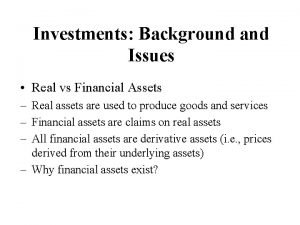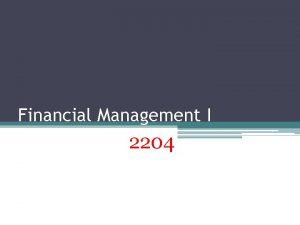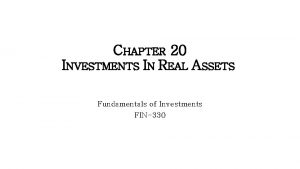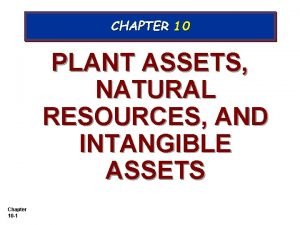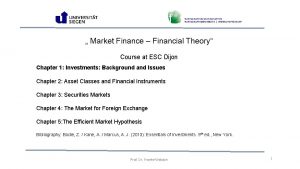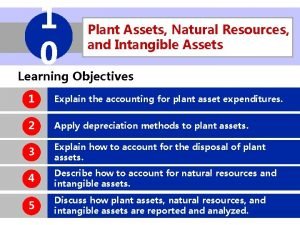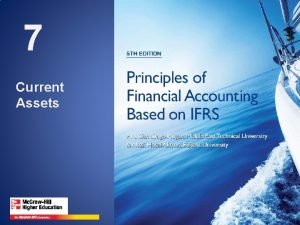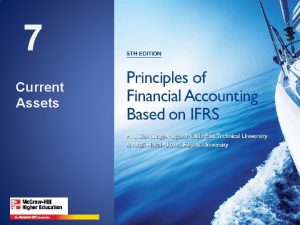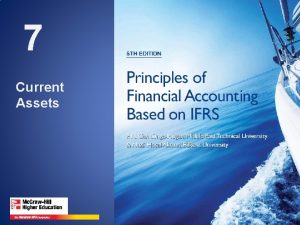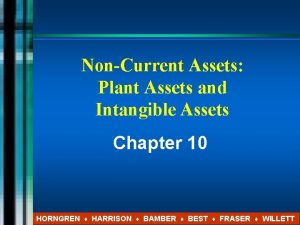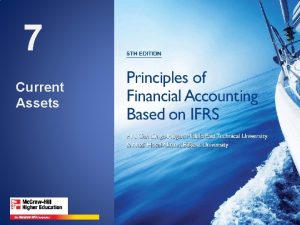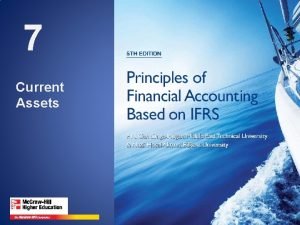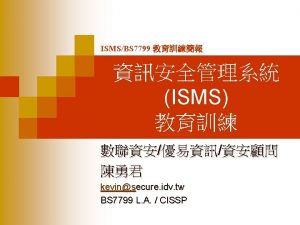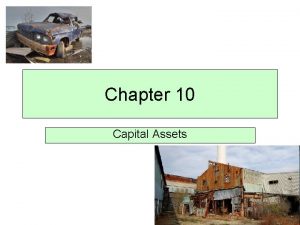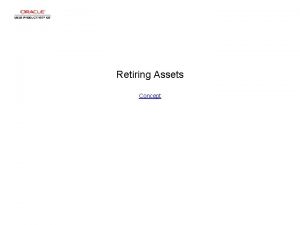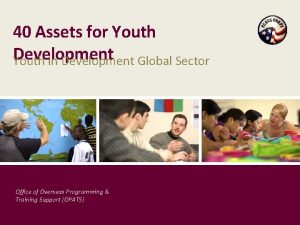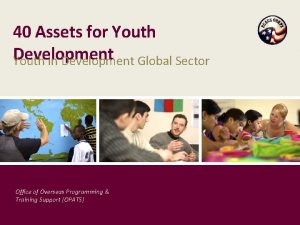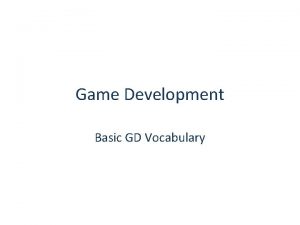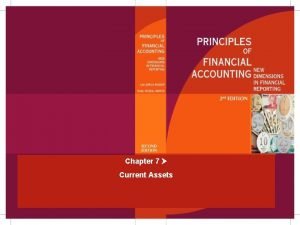40 Assets for Youth Development Youth in Development














- Slides: 14

40 Assets for Youth Development Youth in Development Global Sector Office of Overseas Programming & Training Support (OPATS)

Recalling Peace Corps’ Approach Three guiding principles: 1. Practice positive youth development 2. Enhance youth participation 3. Practice asset-based community development

In this session, we want to: 1. Identify the four internal and four external categories of developmental assets. 2. Explain the value of building assets 3. Identify examples of activities which support building assets.

Search Institute’s Research § 1989 -1996, surveyed 99, 462 6 th-12 th grade students; § Asked them to identify elements of their families, communities, schools, and relationships which contribute to their being healthy, caring, and responsible. § Identified “ 40 Developmental Assets” that youth described as being important to them. § Since then, Search Institute has surveyed more than 2 million youth, and reinforced original findings.

Why is this important? The Power of Assets: • As number of assets present increases, highrisk, destructive behaviors decrease; • As number of assets present increases, constructive, positive behaviors increase.

The Power of Assets to Promote The Search Institute’s research shows that the more assets students report having, the more likely they are to also report the following patterns of thriving behavior: 77% 91% 86% 84% 73% 69% 63% 52% 51% 45% 29% 58% 31% 20% 8% 0 -10 11 -20 21 -30 31 -40 Assets Exhibits Leadership Has been a leader of an organization or group in the past 12 months. 0 -10 11 -20 21 -30 31 -40 Assets Maintains Good Health Takes good care of body (such as eating foods that are healthy and exercising regularly). 0 -10 11 -20 21 -30 31 -40 Assets Values Diversity Thinks it is important to get to know people of other racial/ethnic groups. 0 -10 11 -20 21 -30 31 -40 Assets Succeeds in School Gets mostly A’s on report card (an admittedly high standard). Reprinted with permission from Developmental Assets: A Synthesis of the Scientific Research on Adolescent Development by Peter C. Scales and Nancy Leffert. Copyright 1999, 2004 Search Institute, 615 First Avenue NE, Minneapolis, MN; 800 -8887828; www. search-institute. org. No other use is permitted without prior permission from Search Institute, 615 First Avenue NE, Minneapolis, MN 55413; www. search-institute. org. All rights reserved.

The Power of Assets to Protect The Search Institute’s research shows that the more assets a young person reports having, the less likely he or she is to make harmful or unhealthy choices. (Note that these definitions are set rather high, suggesting ongoing problems, not experimentation. ) 60% 41% 34% 14% 4% Problem Alcohol Use Has used alcohol three or more times in the past 30 days or got drunk once or more in the past two weeks. 21% 19% 6% 11% 3% 1% 0 -10 11 -20 21 -30 31 -40 Assets Assets Violence Has engages in three or more acts of fighting, hitting, injuring a person, carrying a weapon, or threatening physical harm in the past 12 months. Illicit Drug Used illicit drugs (marijuana, cocaine, LSD, PCP or angel dust, heroin, or amphetamines) three or more times in the past 12 months. 0 -10 11 -20 21 -30 31 -40 Assets Sexual Activity Has had sexual intercourse three or more times in lifetime. Reprinted with permission from Developmental Assets: A Synthesis of the Scientific Research on Adolescent Development by Peter C. Scales and Nancy Leffert. Copyright 1999, 2004 Search Institute, 615 First Avenue NE, Minneapolis, MN; 800 -8887828; www. search-institute. org. No other use is permitted without prior permission from Search Institute, 615 First Avenue NE, Minneapolis, MN 55413; www. search-institute. org. All rights reserved.

The Gap in Assets Among Youth The Search Institute’s data suggest that 31 is a worthy, though challenging, benchmark for experiencing their positive effects most strongly. Yet only 11 percent of youth have 31 or more assets. More than half have 20 or fewer assets. 11% 13% 0 -10 Assets 37% 39% 11 -20 Assets 21 -30 Assets 31 -40 Assets Reprinted with permission from Developmental Assets: A Synthesis of the Scientific Research on Adolescent Development by Peter C. Scales and Nancy Leffert. Copyright 1999, 2004 Search Institute, 615 First Avenue NE, Minneapolis, MN; 800 -8887828; www. search-institute. org. No other use is permitted without prior permission from Search Institute, 615 First Avenue NE, Minneapolis, MN 55413; www. search-institute. org. All rights reserved.

Who Builds Assets? . . . Asset Builders! Reflect: Think about people in your own lives who have helped to build assets for you. It’s okay to list same person for more than one question; and it’s okay to leave some blank.

Let’s look at all 40 assets § Each person gets 1 – 3 assets. § Cluster in small groups; 4 external, and 4 internal assets. § Consider your asset example and discuss how it fits together with others in the cluster. § Identify activities in current programs, which support asset-building; write them on sticky notes and attach to your asset, or write the example on your asset.

Build the asset wall § External Assets: Support, Empowerment, Boundaries & Expectations, Constructive Use of Time § Internal Assets: Commitment to Learning, Positive Values, Social Competencies, Positive Identify

Key Points § If all assets are present, the youth is as strong as a brick wall § If we take some away, that youth will survive, but become weaker § If we take away a lot of assets, the youth will have less ability to withstand outside pressures and make good decisions. (See “Power of Assets” handout)

More Key Points! § All young people can benefit from more assets than they already have. § All adults, young people and children can get involved and play a role small or large. § Relationships are essential to build assets. § Asset building starts early and is ongoing through life. § Young people need to receive consistent messaging about what is important and what can be gained by building assets. § Over time and over trouble continue reinforcing assets over the years in all areas of life. § Some things worth doing are worth overdoing!

In groups of 4 -6… § Quickly brainstorm potential activities which can be done in your programs and communities, which will build assets.
 Real assets vs financial assets
Real assets vs financial assets Real assets vs financial assets
Real assets vs financial assets Real assets and financial assets ppt
Real assets and financial assets ppt Truck and plant assets
Truck and plant assets Accumulated depreciation straight line method
Accumulated depreciation straight line method Lanni products is a start up computer
Lanni products is a start up computer Plant assets, natural resources, and intangible assets
Plant assets, natural resources, and intangible assets Fspos
Fspos Novell typiska drag
Novell typiska drag Tack för att ni lyssnade bild
Tack för att ni lyssnade bild Returpilarna
Returpilarna Varför kallas perioden 1918-1939 för mellankrigstiden
Varför kallas perioden 1918-1939 för mellankrigstiden En lathund för arbete med kontinuitetshantering
En lathund för arbete med kontinuitetshantering Underlag för särskild löneskatt på pensionskostnader
Underlag för särskild löneskatt på pensionskostnader Tidbok
Tidbok
